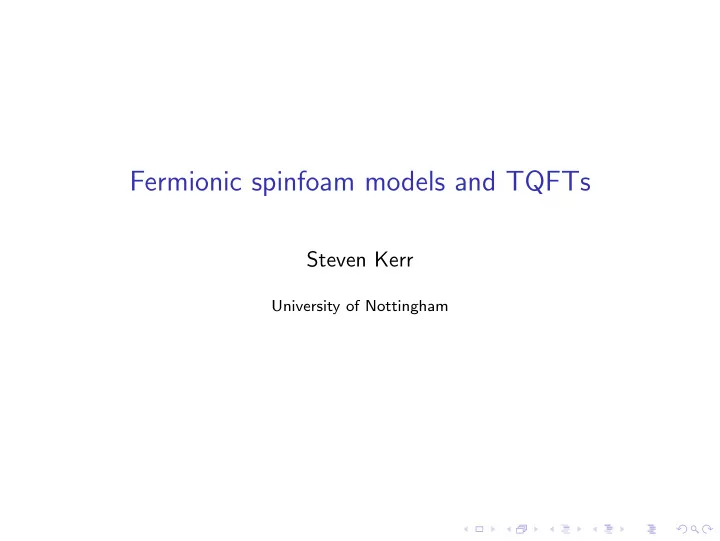

Fermionic spinfoam models and TQFTs Steven Kerr University of Nottingham
Quantum Gravity ◮ Sum over Histories
Quantum Gravity ◮ Sum over Histories � D g e iS ” Z = “
Quantum Gravity ◮ Sum over Histories � D g e iS ” Z = “ ◮ Fundamental length scale
Quantum Gravity ◮ Sum over Histories � D g e iS ” Z = “ ◮ Fundamental length scale
Problems ◮ Triangulation independence
Problems ◮ Triangulation independence ◮ Absence of matter
Problems ◮ Triangulation independence ◮ Absence of matter ◮ We take the point of view that matter and triangulation independence are crucial!
Induced actions � ψ / D ψ D ψ e i � D ψ D = γ µ ( d µ − iA µ ) / Z =
Induced actions � � ψ / D ψ D ψ e i D ψ D = γ µ ( d µ − iA µ ) / Z = D ) = e t r ln i / D = det( i /
Induced actions � ψ / D ψ D ψ e i � D ψ D = γ µ ( d µ − iA µ ) / Z = D ) = e t r ln i / D = det( i / = e iS eff
Induced actions � ψ / D ψ D ψ e i � D ψ D = γ µ ( d µ − iA µ ) / Z = D ) = e t r ln i / D = det( i / = e iS eff ◮ John Barret has suggested that the Standard Model can be induced in this way: arXiv:1101.6078v2 [hep-th]
A one dimensional fermionic TQFT
A one dimensional fermionic TQFT ψ ( t ) , ¯ ψ i , ¯ ψ ( t ) , t ∈ [0 , 2 π ] ψ i , i = 1 .. N
A one dimensional fermionic TQFT ψ ( t ) , ¯ ψ i , ¯ ψ ( t ) , t ∈ [0 , 2 π ] ψ i , i = 1 .. N
A one dimensional fermionic TQFT ψ ( t ) , ¯ ψ i , ¯ ψ ( t ) , t ∈ [0 , 2 π ] ψ i , i = 1 .. N Q i = P e i � Adt A ( t )
A one dimensional fermionic TQFT N � � N i =1 ¯ ˆ � d ψ i d ¯ ψ i ( ψ i − Q i +1 ψ i +1 ) Z = ψ i e i =1 ψ N +1 = ψ 1 Q N +1 = Q 1
A one dimensional fermionic TQFT N � � N i =1 ¯ ˆ d ψ i d ¯ � ψ i ( ψ i − Q i +1 ψ i +1 ) Z = ψ i e i =1 ψ N +1 = ψ 1 Q N +1 = Q 1 N � = det(1 − Q ) Q = Q i i =1
A one dimensional fermionic TQFT N � � N i =1 ¯ ˆ � d ψ i d ¯ ψ i ( ψ i − Q i +1 ψ i +1 ) Z = ψ i e i =1 ψ N +1 = ψ 1 Q N +1 = Q 1 N � = det(1 − Q ) Q = Q i i =1 ◮ ˆ Z is triangulation independent - a topological invariant!
Action What is the significance of this theory? It is a discretisation of a one dimensional Dirac theory, N ˆ � ¯ S = − i ψ i ( ψ i − Q i +1 ψ i +1 ) i =1 N � Q i +1 ψ i +1 − ψ i � ∆ t = 2 π � ¯ = i ∆ t ψ i ∆ t N i =1
Action What is the significance of this theory? It is a discretisation of a one dimensional Dirac theory, N ˆ � ¯ S = − i ψ i ( ψ i − Q i +1 ψ i +1 ) i =1 N � Q i +1 ψ i +1 − ψ i � ∆ t = 2 π � ¯ = i ∆ t ψ i ∆ t N i =1 � Q i +1 ψ i +1 − ψ i � = / lim D t ψ ( t ) ∆ t → 0 i ∆ t � 2 π N � ∆ t → 0 ∆ t lim = dt 0 i =1 � ˆ dt ψ / lim S = D ψ ∆ t → 0
Continuum theory One can calculate the partition function of the continuum theory exactly
Continuum theory One can calculate the partition function of the continuum theory exactly � � dt ψ / D ψ D ψ e i D ψ Z =
Continuum theory One can calculate the partition function of the continuum theory exactly � � dt ψ / D ψ D ψ e i D ψ Z = We find that ˆ Z = Z !
Continuum theory One can calculate the partition function of the continuum theory exactly � � dt ψ / D ψ D ψ e i D ψ Z = We find that ˆ Z = Z ! Naturally, one would like to try do something similar in higher dimensions. This is the subject of current investigation.
Thanks!
Recommend
More recommend